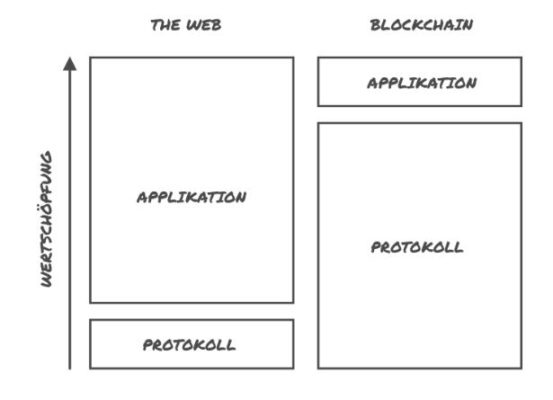Although now partially forgotten, to remember the beginnings of the Internet in many ways to the developments that we see today in the Blockchain industry. I do not mean the often-mentioned Hype-cycle of the bursting of the bubble and the subsequent resurrection. Rather, I mean the ideological and infrastructural Similarities.
In the first years of the Internet, a close-knit and idealistic developer community has created open protocols. These protocols (such as TCP/IP, HTTP, SMTP) promised a simple information exchange at a global level. Until today they are the Foundation of the Internet.
Contents
Fair competition and open exchange of data
In the early stages of the Internet, ruled fair conditions of competition. Any talented developer could use Internet protocols to create services such as search engines, browsers, Online stores, etc. However, the Internet protocols were not extensive enough. You specified a Standard for open data exchange, but not for the storage and monetization of data.
In the absence of such Standards of the Internet, companies have a strong interest in it, to save data centrally. For web-start applications as an empty frame, useful you are, if you are fed up with users and data. As the popular Internet companies developed this fast competitive advantages, to obtain, one can still today hardly. From pure applications, platforms and App Stores, where other company constructions services and, increasingly, in a relationship of dependence.
Facebook, Yelp, Google & Co.
The Problem is that oligopolies (“GAFA”), but that these platforms started as a place for deer to be listed. As evidence one can point to the seemingly endless list of Facebook scandals, or the removal of the Yelp-recommendations by Google to promote its own service called “Places”, or the Change in the Twitter API terms of use and the associated expulsion of more than 143,000 applications that relied on Twitter. The list of such examples is long.
The point is that platforms have a strong interest in behaviour during the construction phase in the interests of the users, but due to the strong dependence of arbitrary and distortionary behaviour as you like. On the Internet protocols hardly anyone, on the applications talking about today is as good as any. It is clear that the creation of value in Web 2.0 is created at the application level.
Blockchain – The age of the logs
The technology Revolution, the proliferation of crypto-networks, has the potential of this dynamic on its head. Crypto-networks are networks based on the Internet and
- Consensus mechanisms, in order to maintain a decentralized database and update;
- Token to use to move Miner/validator the purpose of the consensus procedure.
These characteristics could usher in the age of the logs. Here, the first characteristic, the public database is the key. Instead of individual silos of information in a competitive environment has been breaking through the network for cross-storage of the data. In it users can your data without any friction from one application to the next take
Who once got his key from a Blockchain Wallet to the next export, it is noticed that the Wallets are mere as user interfaces to serve the same public data on the Blockchain (transactions, account balance, etc.) and for the user to graphically represent.
The same phenomenon can be observed if you look at the development around the Ethereum-based, Peer-to-Peer Lending protocols, such as Maker or Compound. These protocols provide the core functionality for decentralized Lending is needed, and are integrated by dozens of applications.
The Status of the loan, the user can watch in any of these applications. The user interface is for the Commodity, which can replace the User without effort. Much more valuable, however, is the underlying Protocol. Quite unlike the Internet, the value added in the Blockchain-era influence on the Protocol level and not at the application level. You only need to compare the market value of Ethereum (Protocol) with the Coinbase (application) to see that the markets rate the protocols higher than the applications.

Incentive systems in cryptographic networks
The second characteristic, the cryptographic networks of the Central platforms of superior power, are the incentive mechanisms. They are caused by the Interaction of the Token and miners/Validators. These mechanisms guarantee a say in the development of the network. Thus, for example, each user in the network token to sell, if he is not satisfied, and even the code base of the network copy (a Fork), to a competing network to be created.
Unlike the Central platform, cannot encounter a Blockchain so your users in front of the head. Even if it would technically be possible, that a handful of profit-oriented decision-makers takes place undemocratic changes to the Protocol could be forked for the Rest of the community, the Code. Without a significant developer community and continuous Innovation, the value of the “old” Blockchain would sink quickly.
Of the Other crypto, networks are a Revolution for the funding of Open-Source Software. A scare went some time ago by the Internet community, as the public was that just a developer of full-time employees in the maintenance of a critical and requiring maintenance of the Internet infrastructure project, worked. Vinton Cerf, the inventor of the Internet, reported recently in an Interview and warned that the Internet is still very far away from the original vision, and more basic research is needed.
In the Blockchain-the area of the network, participants have a financial interest, to Finance over the long term in both infrastructure and application projects, in order to increase the value of the Token. This interest in public infrastructure projects there has never been and will lead to a never-before-seen value in the development of protocols.

